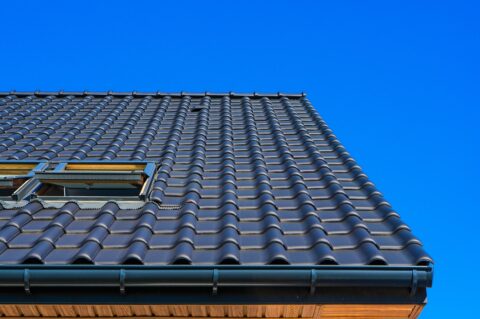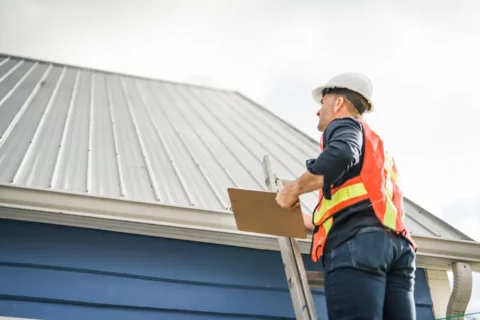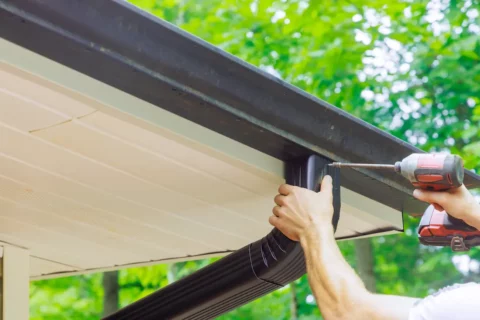
What color of roof is the most energy efficient in Colorado?
Choosing the right roof color for your home can significantly impact your energy bills, especially in a climate like Colorado’s, where temperatures can swing dramatically between hot summers and cold winters. Roof color plays a crucial role in how much heat your home absorbs or reflects, which in turn affects how hard your heating and cooling systems have to work. But what color of roof is the most energy-efficient for Colorado homeowners?
In this blog post, we’ll explore the connection between roof color and energy efficiency, taking into account Colorado’s unique climate. Whether you’re considering a light-colored roof to reflect heat during summer or a darker one for better insulation during winter, we’ll help you understand how your choice of roof color can save you money and make your home more comfortable year-round. Keep reading to find out which roof colors are best suited for energy efficiency in the Centennial State!
The Importance of Roof Color in Energy Efficiency
Roof color plays a crucial role in your home’s energy efficiency by affecting how much heat it absorbs or reflects. Lighter-colored roofs, such as white, beige, or light gray, are more reflective and help bounce sunlight away from your home. This can be especially useful in hotter climates, where keeping your home cool is a priority. In contrast, darker-colored roofs absorb more heat, making them better suited for colder climates where retaining heat is important.
In Colorado, where the climate varies from hot summers to cold winters, selecting a roof color that balances both seasons is essential. A lighter roof can reduce cooling costs in the summer, while a darker one may slightly lower heating costs in the winter. However, the impact of roof color goes beyond just comfort and energy bills; it also affects the lifespan of your roof. Lighter roofs tend to have a longer lifespan in intense sun exposure, common in Colorado’s high-altitude regions.
For Colorado’s mixed climate, light or medium-colored roofs, such as light gray or tan, offer the best energy efficiency. These colors reflect heat during the summer, reducing cooling costs, while still providing some heat retention in the colder months.
Climate Considerations in Colorado
Colorado’s unique climate presents a challenge when selecting the most energy-efficient roof color. The state experiences a wide range of temperatures, from hot summers with intense sunlight to cold, snowy winters. In higher-altitude areas like Denver and Colorado Springs, the sun’s rays are more direct and intense due to the thinner atmosphere, making heat reflection an important factor during the summer months.
Summers in Colorado can bring temperatures well into the 90s, so a roof that reflects heat rather than absorbing it can reduce cooling costs significantly. Lighter-colored roofs, or roofs made with reflective materials, are ideal for reflecting the sun’s rays and keeping homes cooler during these hot months.
However, Colorado’s winters can be harsh, with heavy snowfall and freezing temperatures, particularly in mountainous regions. While darker roofs may absorb more heat, helping with warmth in winter, their overall energy efficiency is diminished in the summer. For this reason, light to medium roof colors are often the best option in Colorado. These colors offer a good balance, reflecting heat during summer while providing enough heat retention in winter to maintain a comfortable indoor temperature, ultimately optimizing energy efficiency year-round.
Light vs. Dark Roof Colors: Pros and Cons
When choosing the most energy-efficient roof color for your Colorado home, it’s important to weigh the pros and cons of light vs. dark roof colors. Each option has distinct advantages, especially in a climate with both hot summers and cold winters.
Light-colored roofs—like white, light gray, or tan—are highly reflective and can reduce cooling costs by reflecting sunlight away from your home. This is particularly beneficial during Colorado’s hot summer months, where temperatures can soar. A light roof can keep your home cooler and ease the strain on your air conditioning system. However, in winter, these roofs may not absorb enough heat to significantly reduce heating costs.
Dark-colored roofs, such as black or dark brown, excel in heat absorption, making them effective for colder climates where maintaining warmth is a priority. However, in a state like Colorado, dark roofs may cause homes to overheat in the summer, driving up cooling costs. Additionally, dark colors can fade faster under intense sun exposure, which is common at Colorado’s high altitudes.
If you’re looking to balance both temperature extremes, medium-toned or light-colored roofs offer the best year-round energy efficiency. For more on durability, check out our article on What color of asphalt shingles last the longest in Colorado.
Reflective Roofing Options for Colorado Homes
Reflective roofing materials are a great choice for maximizing energy efficiency in Colorado’s diverse climate. These roofs are designed to reflect more sunlight and absorb less heat than traditional roofing materials, making them ideal for homes that need to stay cool during hot summer months. In Colorado, where the sun can be intense due to the state’s high altitude, reflective roofing can be a game-changer for homeowners looking to reduce energy bills.
Reflective roofs, often referred to as “cool roofs,” are available in a variety of materials such as reflective asphalt shingles, metal roofing, and tile. These roofs are coated with special pigments or materials that reflect more sunlight. By reducing the amount of heat absorbed, reflective roofing can keep indoor temperatures cooler, reducing the need for air conditioning and lowering energy costs during summer.
In Colorado, where homeowners face both scorching summers and cold winters, pairing reflective roofs with proper insulation is key. This combination allows homes to stay cooler in the summer while still maintaining warmth in the winter, offering year-round energy efficiency. For Colorado homeowners looking to maximize savings and comfort, reflective roofing options are an excellent consideration.
Roof Material and Its Impact on Energy Efficiency
The material of your roof plays a significant role in its overall energy efficiency, especially in Colorado’s variable climate. Different roofing materials have distinct thermal properties that affect how much heat they absorb or reflect, impacting both your cooling and heating costs throughout the year.
Asphalt shingles are a common choice due to their affordability, but they tend to absorb more heat, especially darker-colored ones. However, reflective asphalt shingles are available, which can improve energy efficiency by reflecting sunlight and reducing heat absorption. For those considering asphalt, lighter colors or reflective options can provide better energy performance.
Metal roofing is another excellent option for Colorado homes. Metal roofs are highly reflective and can effectively bounce back sunlight, keeping homes cooler in the summer. Metal is also durable and performs well in Colorado’s winter conditions, offering long-lasting protection with energy benefits.
Clay and concrete tiles also provide good insulation, keeping homes cooler in summer and warmer in winter. Their thermal mass helps regulate temperature, which can reduce energy costs.
Choosing the right material, in combination with the right roof color, will have a significant impact on your home’s energy efficiency. Proper insulation and ventilation are key factors in optimizing the energy-saving potential of any roof material.
Choosing the Right Roof Color for Your Home
Selecting the right roof color for your Colorado home involves balancing energy efficiency with aesthetic preferences and the state’s variable climate. Light-colored roofs, such as white, beige, or light gray, are highly reflective, helping to keep homes cool during the summer months by bouncing sunlight away. These colors are especially effective in reducing cooling costs in regions with intense sunlight, like Colorado’s high-altitude areas.
However, darker roof colors, such as black, dark brown, or charcoal, may absorb more heat, which can be beneficial during Colorado’s cold winters by keeping your home warmer. But this comes at the cost of increased cooling expenses in the hotter months, as darker roofs retain more heat.
To strike the right balance, consider choosing a light to medium color like light gray or tan. These shades offer energy efficiency during the summer by reflecting heat while still providing some warmth retention during winter. Additionally, consider reflective roofing materials, which can further improve energy savings without compromising your preferred color.
Ultimately, choosing a roof color that suits your home’s style while enhancing energy efficiency year-round is key to creating a comfortable living environment and lowering energy costs.
Additional Tips for Improving Roof Energy Efficiency
In addition to choosing the right roof color, there are several other strategies you can implement to improve your roof’s energy efficiency in Colorado. Proper insulation, ventilation, and material selection all play key roles in optimizing how your roof manages temperature, helping to reduce energy costs and maintain a comfortable home environment.
Improve roof insulation: Ensuring that your attic and roof are properly insulated is one of the most effective ways to reduce heat transfer. Good insulation helps retain warmth during Colorado’s cold winters and prevents excess heat from entering your home during the hot summer months.
Enhance ventilation: Proper roof ventilation allows hot air to escape in the summer and reduces moisture buildup in the winter, preventing potential damage. Ridge vents, soffit vents, and attic fans can improve airflow, reducing strain on your heating and cooling systems.
Install energy-efficient materials: Consider installing energy-efficient roofing materials such as cool roofs or reflective shingles. These materials are designed to reflect more sunlight and absorb less heat, improving overall energy performance.
Combining these tips with the right roof color will maximize your home’s energy efficiency, ensuring that your roof not only looks great but also performs well throughout Colorado’s varying seasons.
Conclusion
Choosing the right roof color and materials is essential for maximizing energy efficiency in Colorado’s unique climate. Whether you’re aiming to reduce cooling costs in the summer or keep your home warmer in the winter, the decisions you make about your roof can have a significant impact on your comfort and energy bills year-round.
At 303 Roofer, we understand the importance of selecting the right roof for your home, and we’re here to help. Our team of experts can guide you through the process of choosing the most energy-efficient roofing options, from color selection to material recommendations, tailored specifically to Colorado’s climate. We offer free consultations and comprehensive roof evaluations to ensure your roof performs at its best.
Contact us today to schedule your free roof evaluation and consultation. We’ll assess your current roof and provide personalized recommendations to enhance its energy efficiency and longevity. Whether you’re looking to upgrade or replace your roof, our experienced team will help you make informed decisions that save you money and improve your home’s energy performance. Don’t wait—reach out to 303 Roofer now and start optimizing your roof for year-round comfort and savings!



